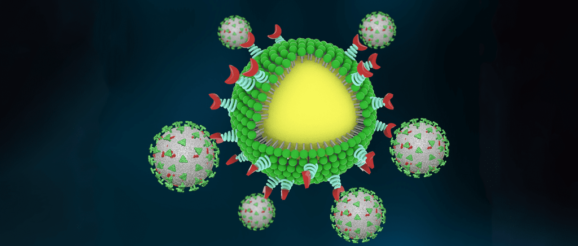Using nanotraps to capture SARS-CoV-2 viruses in the body – Innovation Toronto

Made of FDA-approved polymers and phospholipids, the nanoparticles are about 500 nanometers in diameter—much smaller than a cell. That means the nanotraps can reach more areas inside the body and more effectively trap the virus.
Then, to check to make sure the tiny particles looked the way they expected, they partnered with the lab of Assoc. Prof. Bozhi Tian to use electron microscopes to get a good look. “From our imaging, we saw a solid core and a lipid bilayer shell. That’s the essential part because it mimics the cell,” said Tian, who is appointed in the Department of Chemistry.
The researchers tested the safety of the system in a mouse model and found no toxicity. They then tested the nanotraps against a pseudovirus—a less potent model of a virus that doesn’t replicate—in human lung cells in tissue culture plates and found that they completely blocked entry into the cells.
Once the pseudovirus bound itself to the nanoparticle—which in tests took about 10 minutes after injection—the nanoparticles used a molecule that calls the body’s macrophages to engulf and degrade the nanotrap. Macrophages will generally eat nanoparticles within the body, but the nanotrap molecule speeds up the process. The nanoparticles were cleared and degraded within 48 hours.
The researchers also tested the nanoparticles with a pseudovirus in an ex vivo lung perfusion system—a pair of donated lungs that is kept alive with a ventilator—and found that they completely blocked infection in the lungs.
They also collaborated with researchers at Argonne National Laboratory to test the nanotraps with a live virus (rather than a pseudovirus) in an in vitro system. They found that their system inhibited the virus 10 times better than neutralizing antibodies or soluble ACE2 alone.
A potential future treatment for COVID-19 and beyond
Next the researchers hope to further test the system, including more tests with a live virus and on the many virus variants.
“That’s what is so powerful about this nanotrap,” Rosenberg said. “It’s easily modulated. We can switch out different antibodies or proteins or target different immune cells, based on what we need with new variants.”
The nanotraps can be stored in a standard freezer and could ultimately be given via an intranasal spray, which would place them directly in the respiratory system and make them most effective.
The nanotraps can be stored in a standard freezer and could ultimately be given via an intranasal spray.
The researchers say it is also possible to serve as a vaccine by optimizing the formulation.
“This nanomaterial engineering approach provides a versatile platform to clear viruses, and paves the way for designing next-generation vaccines and therapeutics,” said co-author and graduate student Jiuyun Shi.
“This is the starting point,” Huang said. “We want to do something to help the world.”
